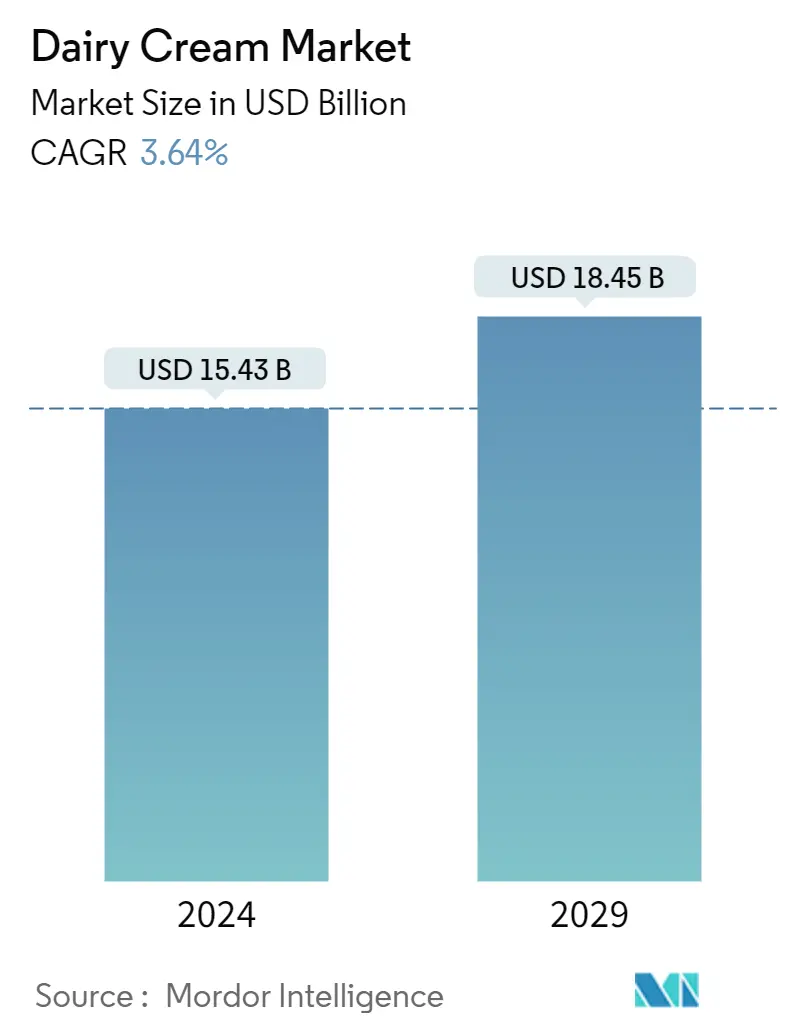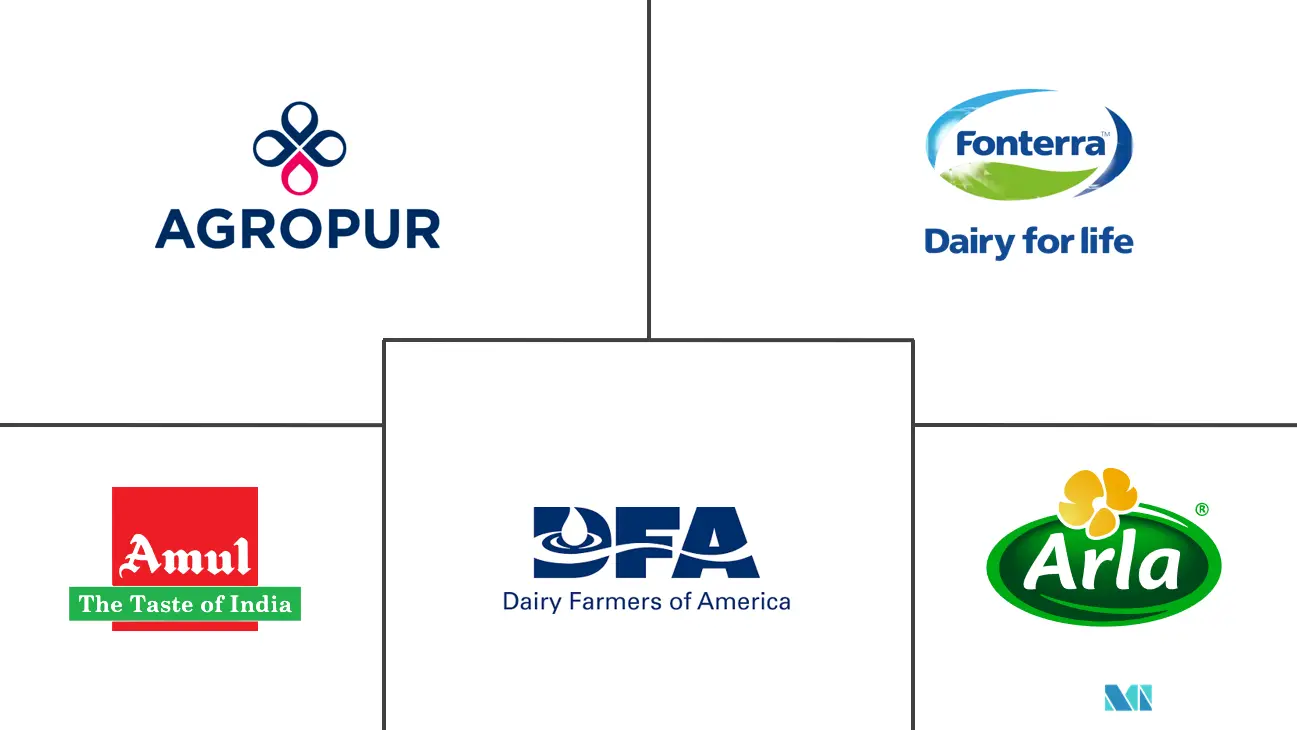Market Size of Dairy Cream Industry

| Study Period | 2019 - 2029 |
| Market Size (2024) | USD 15.43 Billion |
| Market Size (2029) | USD 18.45 Billion |
| CAGR (2024 - 2029) | 3.64 % |
| Fastest Growing Market | Middle East and Africa |
| Largest Market | Europe |
| Market Concentration | Low |
Major Players
*Disclaimer: Major Players sorted in no particular order |
Dairy Cream Market Analysis
The Dairy Cream Market size is estimated at USD 15.43 billion in 2024, and is expected to reach USD 18.45 billion by 2029, growing at a CAGR of 3.64% during the forecast period (2024-2029).
Consumers are willing to opt for low-calorie cream cheese with cleaner ingredients or no artificial ingredients for flavoring and coloring, as well as higher protein content and an improved nutritional profile. Since it is ideal for keto dishes owing to its nutritional value and also used to enhance the taste and preference of the consumers.
Increased government-run health and wellness campaigns aimed at combating obesity and other health-related problems such as diabetes, high blood pressure, heart disease, and high cholesterol are encouraging consumers to buy healthier products like low-fat dairy creams. Companies entering this market are expected to have a high potential due to consumers' preference for functional/organic products. For example, Schulz organic dairy provides pure dairy cream, which is increasingly popular among Australian consumers.
Manufacturers engaged in the business of dairy cream emphasize new product development with a complete solution from which they satisfy several types of cooking requirements like restaurants, hotels, and homes. The nutrition aspect of the product appears to be the primary focus of the producers by offering pasteurized milk and cream, especially low-fat cream. Increasing health awareness among consumers has led to the demand for low-fat dairy creams in the global market.
However, increasing penetration from manufacturers towards plant-based cream products can hinder the potential market for dairy cream over the forecast period. For instance, In February 2023, Alamance Foods launched three distinct flavors of dairy-free substitutes for whipped cream such as oat, almond, and coconut.
Dairy Cream Industry Segmentation
The cream is a dairy product prepared from milk and has a certain level of saturated fat content. It can be used in a variety of recipes and dishes such as spicy, sweet, and salty, sauces, ice cream, and various others. The dairy cream market is segmented into type, distribution channels, and geography. Based on type, the market is segmented into fresh cream, thickened cream/heavy cream, whipping cream, sour cream, and other types. Based on the distribution channel, the market is segmented into supermarkets/hypermarkets, convenience stores, online retail stores, and other distribution channels. Based on geography, the market is segmented into North America, Europe, Asia-Pacific, South America, and Middle East & Africa. For each segment, the market sizing and forecasts have been done on the basis of value (in USD million).
| Type | |
| Fresh Cream | |
| Thickened Cream / Heavy Cream | |
| Whipping Cream | |
| Sour Cream | |
| Other Types |
| Distribution Channel | |
| Supermarkets/ Hypermarkets | |
| Convenince Stores | |
| Online Retail Stores | |
| Other Distribution Channels |
| Geography | |||||||||
| |||||||||
| |||||||||
| |||||||||
| |||||||||
|
Dairy Cream Market Size Summary
The dairy cream market is poised for steady growth, driven by evolving consumer preferences and health trends. There is a notable shift towards low-calorie and organic dairy creams, as consumers increasingly seek products with cleaner ingredients and enhanced nutritional profiles. This trend is supported by government health initiatives aimed at reducing obesity and related health issues, which encourage the consumption of healthier dairy options. Companies entering the market are capitalizing on the demand for functional and organic products, with manufacturers focusing on new product development to cater to diverse culinary needs across restaurants, hotels, and homes. The emphasis on nutrition, particularly in low-fat and pasteurized offerings, is a key strategy for producers aiming to meet the rising health consciousness among consumers.
Despite the promising growth prospects, the dairy cream market faces challenges from the growing popularity of plant-based alternatives, which could potentially hinder its expansion. The demand for lactose-free and organic sour cream is on the rise, driven by increased consumer acceptance and the prevalence of lactose intolerance. This presents a significant opportunity for dairy alternative manufacturers. In regions like the Gulf Cooperation Council, the market is bolstered by a growing population and rising disposable incomes, with consumers seeking innovative and high-quality dairy products. Strategic partnerships and investments by companies such as Arla Foods are enhancing production capabilities and expanding market reach, particularly in countries like Kuwait. The competitive landscape is marked by both regional and international players, with key companies leveraging online marketing and social media to expand their customer base and product offerings.
Dairy Cream Market Size - Table of Contents
-
1. MARKET DYNAMICS
-
1.1 Market Drivers
-
1.2 Market Restraints
-
1.3 Porter's Five Forces Analysis
-
1.3.1 Threat of New Entrants
-
1.3.2 Bargaining Power of Buyers/Consumers
-
1.3.3 Bargaining Power of Suppliers
-
1.3.4 Threat of Substitute Products
-
1.3.5 Intensity of Competitive Rivalry
-
-
-
2. MARKET SEGMENTATION
-
2.1 Type
-
2.1.1 Fresh Cream
-
2.1.2 Thickened Cream / Heavy Cream
-
2.1.3 Whipping Cream
-
2.1.4 Sour Cream
-
2.1.5 Other Types
-
-
2.2 Distribution Channel
-
2.2.1 Supermarkets/ Hypermarkets
-
2.2.2 Convenince Stores
-
2.2.3 Online Retail Stores
-
2.2.4 Other Distribution Channels
-
-
2.3 Geography
-
2.3.1 North America
-
2.3.1.1 United States
-
2.3.1.2 Canada
-
2.3.1.3 Mexico
-
2.3.1.4 Rest of North America
-
-
2.3.2 Europe
-
2.3.2.1 Spain
-
2.3.2.2 United Kingdom
-
2.3.2.3 France
-
2.3.2.4 Germany
-
2.3.2.5 Russia
-
2.3.2.6 Italy
-
2.3.2.7 Rest of Europe
-
-
2.3.3 Asia-Pacific
-
2.3.3.1 China
-
2.3.3.2 Japan
-
2.3.3.3 India
-
2.3.3.4 Australia
-
2.3.3.5 Rest of Asia-Pacific
-
-
2.3.4 South America
-
2.3.4.1 Brazil
-
2.3.4.2 Argentina
-
2.3.4.3 Rest of South America
-
-
2.3.5 Middle East & Africa
-
2.3.5.1 South Africa
-
2.3.5.2 United Arab Emirates
-
2.3.5.3 Rest of Middle East & Africa
-
-
-
Dairy Cream Market Size FAQs
How big is the Dairy Cream Market?
The Dairy Cream Market size is expected to reach USD 15.43 billion in 2024 and grow at a CAGR of 3.64% to reach USD 18.45 billion by 2029.
What is the current Dairy Cream Market size?
In 2024, the Dairy Cream Market size is expected to reach USD 15.43 billion.

